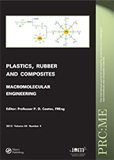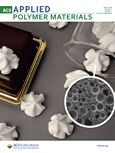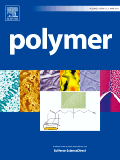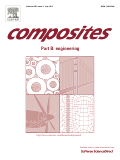
PLASTICS RUBBER AND COMPOSITES
Scope & Guideline
Unveiling the Potential of Composite Materials
Introduction
Aims and Scopes
- Polymer Characterization and Modification:
Research on the mechanical, thermal, and morphological properties of polymers and their composites, often involving modifications to enhance performance or introduce new functionalities. - Composite Materials Development:
Focus on the formulation and optimization of composite materials, including natural and synthetic fibers, nanocomposites, and bio-composites, aimed at improving mechanical properties and sustainability. - Additive Manufacturing and Processing Techniques:
Investigation of various fabrication techniques, particularly additive manufacturing methods like 3D printing, and their effects on the properties of polymeric materials. - Sustainable and Green Materials:
Emphasis on the development of sustainable materials, including the recycling of waste plastics and the use of biodegradable components to reduce environmental impact. - Performance Evaluation under Real-world Conditions:
Studies assessing the performance of polymeric materials under various environmental conditions, including temperature, moisture, and mechanical stress, to predict longevity and reliability in applications.
Trending and Emerging
- Biodegradable and Bio-based Composites:
There is a marked increase in research focusing on biodegradable materials and bio-based composites, reflecting a global shift towards sustainability and reducing plastic waste. - Nanocomposites and Advanced Functional Materials:
The incorporation of nanomaterials, such as carbon nanotubes and graphene, into polymer matrices to enhance mechanical, thermal, and electrical properties is gaining significant attention. - 3D Printing and Additive Manufacturing Innovations:
The exploration of 3D printing technologies and their application in creating complex polymer structures has become a prominent theme, driven by advancements in additive manufacturing. - Performance Under Extreme Conditions:
Research investigating the performance of materials under extreme conditions, such as high temperatures or corrosive environments, is on the rise, addressing the demand for more durable materials. - Smart and Responsive Materials:
Emerging studies on materials that can respond to environmental stimuli (temperature, pH, etc.) are increasingly common, indicating a trend towards the development of 'smart' materials.
Declining or Waning
- Traditional Rubber Compounding:
Research related to conventional rubber compounding techniques and formulations has seen a decrease, possibly due to the industry's move towards more advanced materials and methodologies. - Basic Polymer Processing Techniques:
There has been a waning interest in basic polymer processing techniques that do not incorporate newer technologies or innovations, as researchers increasingly seek more advanced methods. - Conventional Flame Retardancy Studies:
While flame retardancy remains important, studies focusing solely on traditional methods without integrating new materials or technologies have become less frequent.
Similar Journals

AIMS Materials Science
Connecting Scholars to the Future of MaterialsAIMS Materials Science is an esteemed open-access journal dedicated to advancing the field of materials science. Published by the American Institute of Mathematical Sciences (AIMS), this journal has been a vital resource for researchers, professionals, and students since its inception in 2014. With an ISSN of 2372-0468 and an E-ISSN of 2372-0484, it focuses on disseminating high-quality research in materials science, ranging from general materials science to cutting-edge advancements in innovative materials applications. Currently ranked Q3 in the 2023 Scopus Materials Science (miscellaneous) category, with a ranking of 253/463, AIMS Materials Science strives to provide an open forum for scholarly dialogue and collaboration, ensuring valuable insights are accessible to the global scientific community. The journal's commitment to open access enhances its visibility and reach, further promoting impactful research in this dynamic field.

Polymer-Plastics Technology and Materials
Empowering Global Collaboration in Polymer StudiesPolymer-Plastics Technology and Materials is a premier academic journal published by Taylor & Francis Inc., dedicated to the dynamic fields of chemical engineering, materials chemistry, and polymers and plastics. With an impact factor that reinforces its reputation, this journal is strategically indexed in Scopus, ranked notably within its categories (Q2), showcasing its influence and relevance in the academic community. Since its inception in 2019, the journal has served as an essential platform for researchers, professionals, and students to disseminate innovative studies and advancements in polymer science and materials technology. As an Open Access publication, it ensures that cutting-edge research is accessible to a global audience, fostering collaboration and knowledge sharing in the material sciences. Located in the United Kingdom, Polymer-Plastics Technology and Materials continues to enhance the dialogue within the industry, addressing critical challenges and exploring emerging trends that shape the future of polymer and plastics technologies.

ACS Applied Polymer Materials
Exploring the Frontiers of Polymer ResearchACS Applied Polymer Materials is a prestigious journal published by the American Chemical Society, specifically tailored for the dynamic fields of Organic Chemistry, Polymers and Plastics, and Process Chemistry and Technology. With its ISSN 2637-6105, the journal has rapidly established itself within the academic community, achieving a distinguished Q1 quartile ranking across multiple categories in 2023. This places it among the top-tier journals globally, reinforcing its critical role in disseminating groundbreaking research and innovation in polymer science. The journal is known for its rigorous peer-review process and publishes high-quality articles that are pivotal for researchers, professionals, and students eager to advance knowledge in polymer materials and their applications. Positioned to cover converging themes from 2019 through 2024, ACS Applied Polymer Materials embraces a wide scope of studies, from fundamental chemistry to practical engineering applications, thereby fostering significant advancements in material science. While it offers traditional access options, the journal's impact is reflected in its impressive rankings within Scopus, indicating its relevance and influence in the chemical engineering domain. Join the global community of innovators and discover the latest insights that continue to shape the landscape of applied polymer research.

FIBERS AND POLYMERS
Advancing the Science of Materials Through InnovationFIBERS AND POLYMERS is a prestigious scholarly journal published by the Korean Fiber Society, specializing in the fields of Chemical Engineering, Chemistry, and Polymer Science. Since its inception in 2000, the journal has provided a dynamic platform for researchers and professionals to disseminate cutting-edge findings and innovative methodologies related to fibers, polymers, and their diverse applications. With its Q2 category ranking across multiple disciplines in 2023 and a commendable standing in Scopus rankings—ranking #183 in General Chemistry and #127 in General Chemical Engineering—it is well-regarded within the academic community. The journal’s commitment to quality research is further underscored by its comprehensive coverage of technological advancements and theoretical developments relevant to both industry and academia. Access to published articles may vary, and authors are encouraged to submit original research to contribute to this evolving field. Join the community shaping the future of materials science through FIBERS AND POLYMERS.

POLYMER
Transforming Ideas into Polymer SolutionsPOLYMER, an esteemed journal published by Elsevier Science Ltd, stands at the forefront of polymer science, presenting cutting-edge research that encompasses the realms of Materials Chemistry, Organic Chemistry, and Polymers and Plastics. With a remarkable impact factor reflecting its significance in the academic community, POLYMER has been a vital resource since its inception in 1960, contributing to a converged body of knowledge through to 2024. Rated Q1 in all relevant categories as of 2023, and boasting impressive Scopus rankings, this journal not only facilitates advanced discussions in polymer synthesis, characterization, and applications but also serves as a critical platform for collaborative research among scholars, professionals, and students. While it offers content primarily via subscription, POLYMER remains dedicated to fostering innovation and excellence in the field, making it an essential read for anyone passionate about polymer science.

Composites Research
Pioneering Insights in Composite Materials ScienceComposites Research is an esteemed academic journal dedicated to advancing the field of composite materials, published by the Korean Society of Composite Materials. With a focus on innovative research and development, this journal serves as a vital platform for researchers, professionals, and scholars in the field, promoting high-quality papers that discuss both theoretical and practical aspects of composite materials. Although it operates under a traditional access model, the journal remains committed to disseminating essential knowledge and cutting-edge findings relevant to the latest trends and technological advancements in composites. The ISSN 2288-2103 and E-ISSN 2288-2111 ensure the widespread visibility and accessibility of published works. The journal is strategically positioned to contribute to the growing body of knowledge in composite research, enabling the exchange of ideas and collaboration among a global audience.

COMPOSITES PART B-ENGINEERING
Driving Excellence in Materials Science and EngineeringCOMPOSITES PART B-ENGINEERING, published by Elsevier Science Ltd, stands at the forefront of research in the fields of engineering and materials science, specifically targeting the domains of composites, ceramics, and mechanical engineering. With an impressive impact factor and categorized in the prestigious Q1 quartiles across multiple categories including Industrial and Manufacturing Engineering and Mechanics of Materials, this journal fosters innovative research that significantly contributes to the advancement of composite materials and their applications. The journal has been diligently publishing high-quality peer-reviewed articles since its inception in 1996, and it continues to attract top-tier contributors and researchers who are dedicated to exploring emergent technologies and methodologies. Researchers, professionals, and students will find valuable insights and an extensive pool of resources in this essential journal, available through Open Access options that enhance its visibility and reach, allowing the dissemination of crucial knowledge to the global scientific community.

Journal of Polymer & Composites
Exploring the Future of Polymer Chemistry and Engineering.Journal of Polymer & Composites, with ISSN 2321-8525 and E-ISSN 2321-2810, is an esteemed academic journal published by STM JOURNALS, dedicated to the advancement of knowledge in the rapidly evolving fields of polymer science and composite materials. The journal serves as a pivotal platform for researchers and professionals, offering cutting-edge research articles, reviews, and case studies that explore innovative developments and applications in polymer chemistry, material science, and engineering. Although currently lacking an impact factor citation, the journal aims to foster dialogue among academia and industry partners, addressing the latest trends and breakthroughs that drive the field forward. With a commitment to scholarly excellence, the Journal of Polymer & Composites is positioned as an essential resource for enhancing the understanding of polymer composites and their multifaceted applications. Notably, STM JOURNALS' reputation for quality publications underscores the journal’s importance in facilitating impactful research and educational initiatives worldwide.

POLYMER SCIENCE SERIES A
Harnessing Expertise in Materials ChemistryPOLYMER SCIENCE SERIES A is a distinguished journal dedicated to the field of polymer science, with a focus on advancing knowledge in materials chemistry and polymers and plastics. Published by MAIK NAUKA/INTERPERIODICA/SPRINGER, this journal provides a platform for researchers and practitioners to disseminate their findings and innovations. With an ISSN of 0965-545X and an E-ISSN of 1555-6107, it is widely accessible to the academic community. Although currently non-open access, the journal has maintained its significance since its inception in 1991, boasting an evolving emphasis on contemporary issues in polymer science up to 2024. Ranked in the Q3 category for both Materials Chemistry and Polymers and Plastics in 2023, POLYMER SCIENCE SERIES A plays a crucial role in the broader academic landscape, particularly for those committed to understanding and enhancing polymer materials. The journal’s reputation is solidified by its Scopus rankings, where it addresses critical advancements and fosters collaborative research opportunities within the community. We invite researchers, professionals, and students to explore the valuable insights published within these pages.

INTERNATIONAL POLYMER PROCESSING
Connecting Professionals through Polymer Research InsightsINTERNATIONAL POLYMER PROCESSING, published by WALTER DE GRUYTER GMBH, serves as a crucial platform for professionals and researchers in the fields of Chemical Engineering, Industrial and Manufacturing Engineering, and Materials Science, particularly focusing on polymers and plastics. With its ISSN 0930-777X and E-ISSN 2195-8602, this journal has been in circulation since 1988 and continues to expand its contributions to contemporary research trends through to 2024. Ranking in the third quartile across multiple categories, including Chemical Engineering (miscellaneous) and Materials Chemistry, it offers insightful and rigorous peer-reviewed articles that enhance the understanding of polymer processing technologies and innovations. This journal is vital for anyone engaged in polymer science and engineering, providing both theoretical and practical perspectives that advance the field. Although it does not provide open access, the journal's content is indispensable for academia and industry professionals looking to stay at the forefront of polymer research.